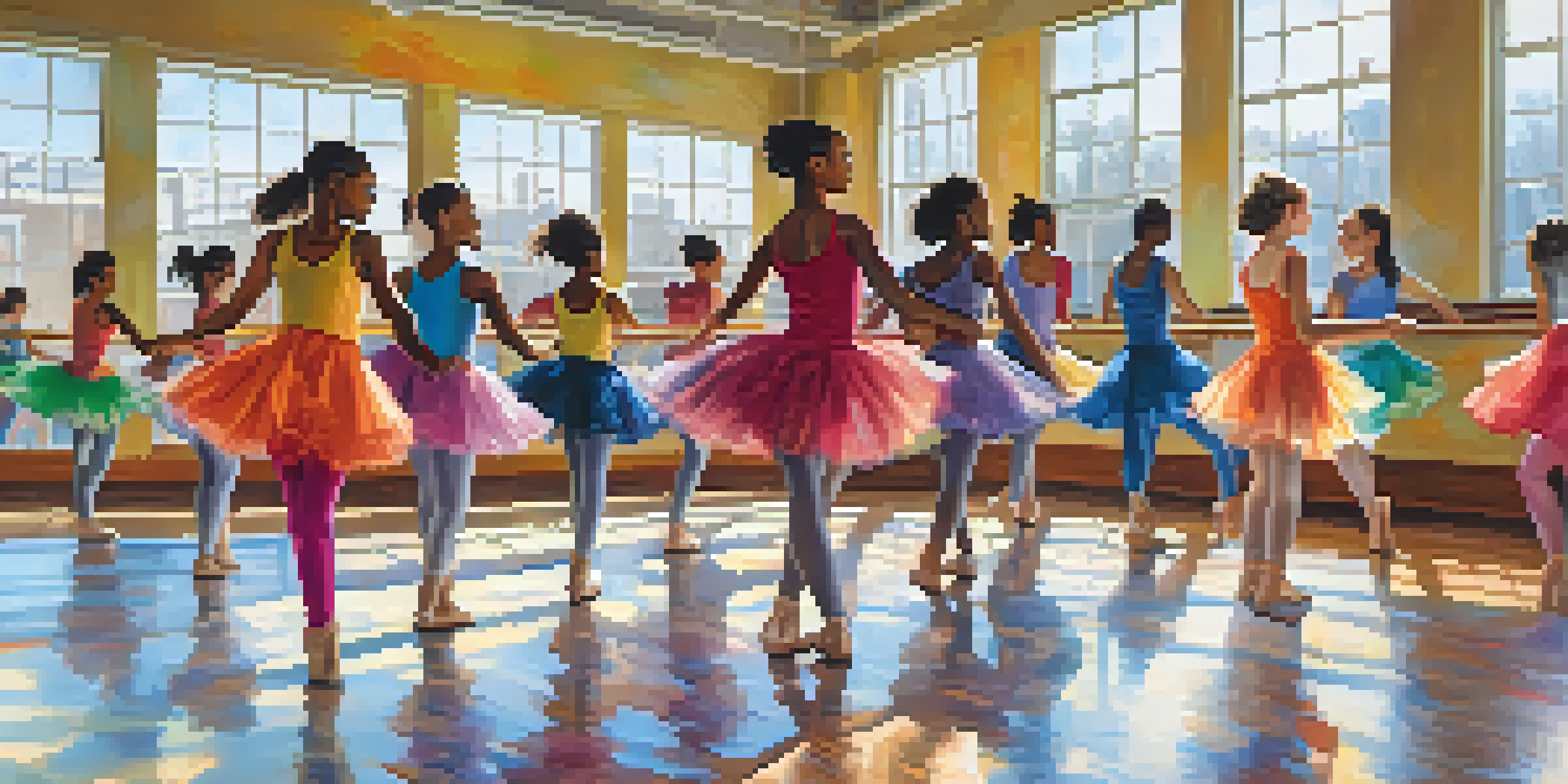Evaluating Dance Programs Focused on Youth in Underserved Areas

Understanding the Importance of Dance Programs for Youth
Dance programs serve as a vital outlet for youth, particularly in underserved areas. They foster creativity, boost self-esteem, and provide a sense of community. By participating in dance, young people can express themselves and explore their emotions through movement.
Dance is the hidden language of the soul.
Moreover, these programs often teach discipline and teamwork, essential skills that extend beyond the dance floor. For many youth, dance becomes a safe haven, a place where they can escape the challenges of their daily lives. This supportive environment can significantly contribute to their overall well-being.
In underserved communities, where access to arts education may be limited, dance programs can fill a critical gap. They not only enhance cultural awareness but also promote inclusivity and diversity. Recognizing the multifaceted benefits of dance is the first step in evaluating these programs' effectiveness.
Identifying Key Elements of a Successful Dance Program
When evaluating dance programs, it's essential to identify key elements that contribute to their success. A well-structured curriculum that balances technique, creativity, and performance opportunities can significantly impact students' engagement. Additionally, experienced instructors who are passionate about teaching can inspire youth to excel.

Another crucial aspect is community involvement. Programs that foster partnerships with local organizations and schools can create a more robust support network for participants. This collaboration helps to ensure that the program meets the needs of its demographic, making it more relevant and effective.
Dance Programs Boost Youth Well-Being
Dance programs provide creative outlets that enhance self-esteem and foster community among youth, especially in underserved areas.
Lastly, assessing student outcomes, such as improvements in confidence and social skills, can provide valuable insights. Programs that track these outcomes can better demonstrate their impact and identify areas for growth, ensuring they continue to serve the community effectively.
Evaluating Accessibility and Inclusivity in Dance Programs
Accessibility is a cornerstone of effective dance programs, especially in underserved areas. Programs should ensure that all youth, regardless of background or ability, have the opportunity to participate. This might include offering classes at various skill levels and providing scholarships for those who cannot afford fees.
The dance is a poem of which each movement is a word.
Inclusivity goes hand-in-hand with accessibility. Programs should celebrate diversity and create an environment where all participants feel welcome. This can be achieved through culturally relevant curriculum choices and outreach efforts that engage different segments of the community.
Evaluating how well a program addresses these factors can reveal its commitment to serving all youth. A truly inclusive program not only enhances participation but also enriches the overall experience for everyone involved.
Assessing the Quality of Instruction and Curriculum
The quality of instruction is paramount in any dance program. Evaluators should look for programs with qualified instructors who possess both pedagogical skills and practical experience. This combination ensures that students receive high-quality training that meets their developmental needs.
In addition to instructor qualifications, the curriculum itself should be assessed. A well-rounded program will incorporate various dance styles and techniques, allowing students to explore their interests. Furthermore, the curriculum should adapt to the changing needs of the students, keeping them engaged and motivated.
Inclusivity Drives Program Success
Accessibility and inclusivity are essential for dance programs, ensuring that all youth can participate and feel welcomed.
Regular feedback from students and parents can also serve as a useful tool for evaluation. Programs that actively seek input demonstrate a commitment to continuous improvement and responsiveness to their community's needs.
Measuring Community Impact and Engagement
An essential aspect of evaluating dance programs is measuring their impact on the community. This includes assessing how well the program engages local residents and fosters a sense of belonging. Successful programs often host community events, performances, and workshops that invite broader participation.
Furthermore, gathering data on student retention rates and community involvement can provide insights into the program's effectiveness. High retention rates often indicate that students find value in the program, while community events can demonstrate the program's role in enhancing local culture.
Ultimately, a program that positively impacts its community can inspire other youth to participate, creating a ripple effect of engagement and support. Evaluating this community-centric approach is crucial for understanding a program's value.
Funding and Sustainability of Dance Programs
The financial health of a dance program can greatly affect its long-term sustainability. Evaluators should examine funding sources, including grants, donations, and partnerships, to ensure the program can continue operating effectively. A diverse funding base can help mitigate risks associated with economic downturns.
Moreover, transparency in financial management is essential. Programs that openly share their budgeting and spending practices can build trust within the community. This trust can lead to increased support from parents, local businesses, and community members.
Feedback Fuels Continuous Improvement
Gathering feedback from participants helps dance programs adapt and thrive, creating a supportive environment for youth development.
Sustainability also involves strategic planning for future growth. Programs should have a clear vision and actionable goals that align with community needs. By focusing on sustainability, dance programs can continue to thrive and benefit youth for years to come.
Gathering Feedback for Continuous Improvement
Feedback is a powerful tool for ongoing program evaluation and enhancement. Dance programs should actively solicit input from students, parents, and instructors to identify strengths and areas for improvement. This collaborative approach fosters a sense of community and ownership among participants.
Surveys, focus groups, and informal discussions can all serve as effective methods for gathering feedback. Insight from various stakeholders can provide a holistic view of the program's effectiveness and inform necessary adjustments. Programs that prioritize feedback are more likely to adapt and remain relevant.

Ultimately, continuous improvement ensures that dance programs can evolve to meet the needs of their participants. By valuing feedback, programs can create a dynamic learning environment that supports youth in their dance journeys.